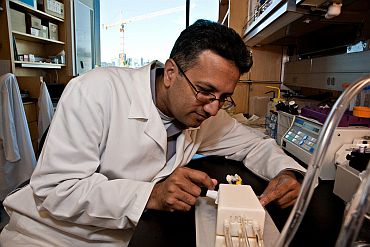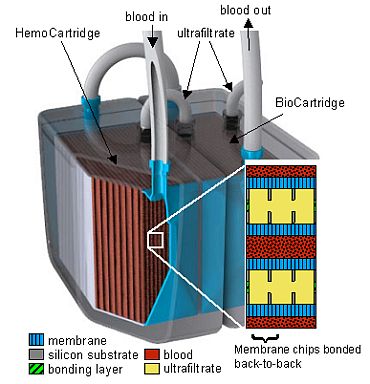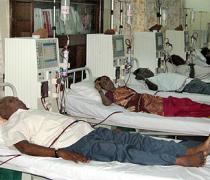Photographs: Kind Courtsey: Shuvo Roy
Shuvo Roy did not want to be a doctor. His father was a public health physician and several family members were doctors. "I wanted to be different," says Roy. "So I studied engineering." Now he leads a team that is hoping to create the world's first artificial kidney, writes Sandip Roy.
To be fair, it's medicine but it's also engineering. Roy is an Associate Professor of Bioengineering and Therapeutic Sciences at the University of California, San Francisco, a joint department of the schools of Pharamacy and Medicine.
He says his interest in the kidney was serendipitous. While working in micro and nanotechnology, Roy met a medical resident who was studying the kidney. He was interested in developing a more efficient dialysis machine.
Roy struck up a relationship and pretty soon started wondering about the possibility of moving kidney therapy into the body using nanotechnology.
"Right now you are tethered to a machine, perhaps three times a week," says Roy. "An artificial kidney could provide you kidney functions 24/ 7."
What's a bigger plus is that an artificial kidney can mimic a kidney's function instead of just removing waste as a dialysis machine does. His kidney comes with a filtration component and a cellular component just like a real kidney.
The filtration is provided through a silicon membrane developed using nanotechnology. "I had a colleague who wanted to use silicon nanotechnology to encapsulate pancreatic cells," says Roy. "And I thought we could do this for a kidney. The goal was could we achieve a good flow rate and selectivity."
The cellular component comes from the patient's own cells or a donor. These cells can work with the filtered blood to perform the other functions of a kidney -- secreting hormones, regulating blood pressure, and tweaking sugar levels.
Please ..
He wants to 'create' kidney to solve dialysis woes
Image: Dr Roy's model of the artificial kidneyPhotographs: Courtsey: Dr Shuvo Roy
The potential impact of an artificial kidney could be huge.
350,000 Americans rely on dialysis. Dialysis costs can be about $75,000 a year. More than 85,000 people in the United States are on the waiting list for a kidney transplant. A transplant costs $25,000 a year after initial surgery. Most of those costs are because of anti-rejection drugs the patient has to take to make sure his body does not reject the new kidney.
Roy's kidney would eliminate the need for those anti-rejection drugs. "I don't think it should be any more expensive in terms of cost than the transplant operation itself," says Roy. He is not sure whether the kidney will ever need to be replaced. His hope is it won't need anything more than minimal tweaks every few years to keep it going.
Over 40 people are working on the project currently. Components have been tested inside animals already. "We have not tested a large scale device in an animal yet," says Roy. "Once we can do that we would have to demonstrate safety in humans." And he'll have to shrink a room-sized external model into something that would be the size of a coffee cup.
That could be five years away. But he probably won't have a shortage of volunteers. Roy already receives dozens of letters from people anxious to see the project succeed. "When I get frustrated I remember those letters," he says. "Letters that say you have given me so much hope, you must keep working. Or one person who said 'I feel like now I can live for something.'"
Roy had family members who suffered from kidney failure but he didn't know anyone undergoing regular dialysis. Born in Bangladesh, he grew up in Uganda. His father was among a wave of Asian professionals who were quietly let back into Uganda after Idi Amin initially kicked all the Asians out.
But both Bangladesh and Uganda are poor countries. Dialysis is an expensive procedure. About 6 percent of the Medicare budget in the US goes for dialysis alone. "I can imagine this kidney could have huge impact in poor countries where something like dialysis is just not available for large sections," says Roy.
He wants to 'create' kidney to solve dialysis woes
Image: Dr Shuvo RoyWhat the project needs though is a benefactor. Initially Roy and his team approached all the usual sources for funding -- the National Institute of Health, NASA, National Science Foundation. They did get some government funding to demonstrate some technological milestones. They were able to take advantage of a special program at the NIH to fund technology intensive projects that would affect a large cross section of people.
Roy has taken his idea to some of the venture capitalists who fund innovation in the Silicon Valley as well. "The feedback is it's very interesting, we'd love to support it but we need to see a little more validation," he says. "A few years ago a lot more people would have taken the risk. In the current economy people want to see it developed a little more."
But he is confident it will all fall into place. Once it does, he knows it won't just affect millions of people who suffer from kidney failure.
"I have medical colleagues who are interested in encapsulating cells that produce insulin," he says. "So we could build artificial pancreas or liver. We could protect cells with a membrane from being attacked by the host's immune system."
The filtration techniques could be applied outside the medical sphere. It could be useful for water filtration in low-resource settings, says Roy. Water could be filtered not just of bacteria but also from endotoxins.
Right now though he and his team are just focused on making one milestone after another. And when he's not in the lab pondering filtration rates, Roy and his wife who moved to the Bay Area a couple of years ago after ten years in Ohio, are trying to take advantage of everything the Bay Area has to offer -- hikes, beach, cultural performances. And a lot more Bengalis.
"We did hit all the Durga Pujas this year," says Roy. "But I do need to be more connected." Perhaps he says it will be through some good fish curry. He ate so much fish growing up, he says he got tired of it. Now he misses his mother's cooking and is rediscovering fish. His wife, an American, is enthusiastic about Indian culture but hasn't quite picked up cooking. And Roy admits he's not a good cook.
A little hilsa curry to help along the world's first artificial kidney -- any takers?








More from rediff